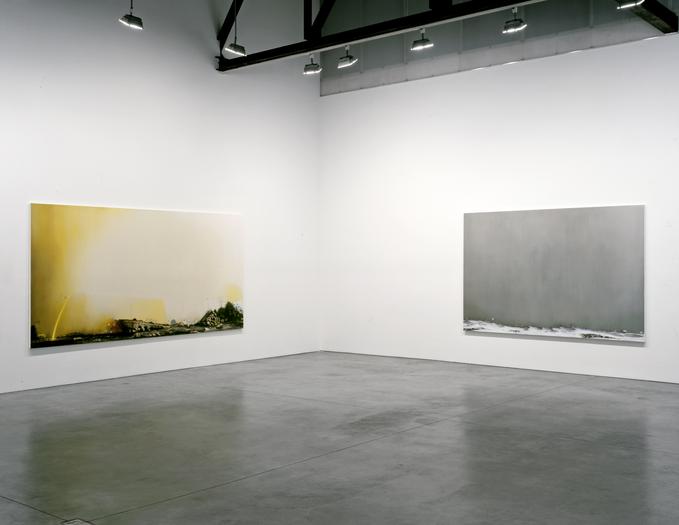Nigel Cooke
April 8 – May 15, 2004
Main Gallery
To view one of Nigel Cooke's paintings is an active experience: you cannot take them in from a single vantage point. Step back to survey the broad sweep of landscape and all detail is lost; stoop in, taking the dizzying plunge to microscopic level and find yourself inching across the surface in an examination of minutiae at the very threshold of visibility. These extremes of scale are amongst the many dualities these paintings hold in tense coexistence. An unreal universe is described with scientifically precise realism. A world governed by entropy and chaos is rendered with supreme order and control. Details abject or bathetic are composed with formal elegance.
The heroic scale of Cooke's landscapes recalls an era of landscape painting that revered the sublime, an elevating communion of man and nature. In his universe, however, man's presence is felt as creeping urban decay, reducing every view to an undifferentiated wasteland of toxic rubble. Where nature rallies, it appears an equally unwholesome force, taking the form of a virulent tangle of jungle creepers. Daylight filters through poisonous yellow smog: night falls, a suffocating and eternal blackness. In Silva Morosa jungle creepers overwhelm the ruins, in Mummy an ice age whites out the landscape. Perhaps a hundred or a thousand years have passed - our sense of time is as confused as our sense of scale.
Despite, or because of, the overwhelming abundance of information they contain, the paintings remain inscrutable. As if to further frustrate our expectation of meaning, independent agencies within them make impotent attempts at communication. Unintelligible and vaguely threatening graffiti seems to originate from some brutish intellect, far removed from the sophisticated organising intelligence behind the painting; meanwhile the landscape itself offers meaningless signs and portents - a skull materialising amongst the leaves, a feeble arc of light which fails to illuminate. In the night painting Mirrors, not only is the blackness of the void impenetrable, but the glossy dark canvas itself is dimly reflective, deflecting our gaze. An opening gapes in the foreground, a potential escape route from this suffocating expanse, but proves to be a pond reflecting only the same blackness. In this closed system reflection does not lead to understanding.
What from a distance appear to be vast empty skies, prove to be blank walls, scrawled with graffiti or stained with nameless effluvia, which crowd the painting into a narrow plane and seal each unhealthy ecosystem. The device is a trope for the contradiction intrinsic to painting, simultaneously flat and illusionistic. The sky, which is a wall, is also a canvas; in Ghost on the Happy Trail a colorfield painting, in Mirrors a black monochrome. Other relics of past movements litter the foreground, like the noble crags of Romanticism pitifully reduced to rocky outcrops. Confronted with painting's terminal state, Cooke aspires to the last word. Imagine the life of painting flashing before its eyes in the last moment before extinction. This universe is his invention of an impossible pile-up at the end of history; a terminal painting gorged on all other paintings, the last of its line. Yet Cooke's heroic investment of care and skill is a validation of painting even as he pronounces its absurdity and obsolescence. New worlds of possibility open up in the very attempt to pin down every imaginable detail in absolute and literal finality.
Nigel Cooke was born in Manchester, England in 1973. He lives and works in London, where he studied at the Royal College of Art and Goldsmiths College. This year his work was exhibited at Tate Britain as part of the ‘Art Now' series.
